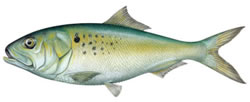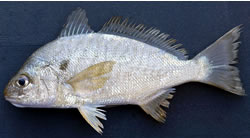  |
Baitfish: Their Importance To Fisheries and the Food Chain |
|
by Deanna Gambino, Hourly Fisheries Technician
Bureau of Marine Fisheries
September 27, 2018
|
Though often overlooked, baitfish are critical to recreational and commercial fishermen both as bait and as a foundation species in the food chain. Learn about the five most common and important species found in the waters off New Jersey.
Atlantic Menhaden Brevoortia tyrannus
Atlantic menhaden are commonly referred to as menhaden or bunker. Historically, these fish were ground up and used as fertilizer for crops or animal feed. According to National Geographic, the menhaden fishery is the largest fishery on the east coast1 of the United States.
Commercially, the menhaden fishery is made up of a reduction fishery and a bait fishery2. The majority of menhaden are fished for reduction, which reduces the menhaden into a fish oil supplement. The remaining commercially fished menhaden are used as bait for the blue crab fishery and for larger fish such as striped bass, weakfish, bluefish and cod. In either case, the fish are caught using a purse seine net. This technique surrounds a school of fish with a net that has a drawstring bottom. This prevents the fish from swimming down to escape.
|

Atlantic Menhaden
Click to enlarge
|
Menhaden are also caught by recreational fishermen with cast nets. These fish are then used as bait for larger species.
Menhaden and other small bait fish are vital to the food chain. They feed on the primary producers of the ocean, such as plankton. In turn, menhaden are a useable source of energy for animals higher in the food chain that feed on them. Menhaden are a common source of food for a wide array of marine life from shellfish to finfish to marine mammals, as well as large shorebirds and other terrestrial animals.
|
Atlantic Silverside Menidia menidia
Atlantic silversides are commonly referred to as silversides or spearing. Silversides are relatively small baitfish with a shore lifespan of 1-2 years.
Silversides are the most common fish in the New York-New Jersey Harbor Estuary3. However, there is little to no documentation on a silverside fishery. Commercially and recreationally, silversides are caught using minnow traps and small seines and used for bait4. In Rhode Island, silversides are known to be used to bait eel pots5.
Silversides are vital to the food chain because they feed on the primary producers of the ocean, such as zooplankton, algae and copepods. Just like menhaden, silversides are a useable source of energy for animals higher in the food chain. Examples of species that feed on silversides include striped bass, bluefish, egrets, gulls and cormorants. Silverside larvae and eggs are a common source of food for blue crabs, mummichogs, ruddy turnstones and semipalmated sandpipers.
|

Atlantic Silverside
Click to enlarge
|
|
American Eel Anguilla rostrata
American eels are the only catadromous fish found in North America6. As opposed to anadromous fish, catadromous fish migrate out of freshwater rivers and estuaries to spawn in the ocean. These eels have a complex life cycle that includes many stages. Eels have been fished and farmed for years because they are considered a delicacy in Europe and Asia7. In the 1970s, the juvenile stage of eels known as glass eels was heavily fished in the United States and sold to the Asian market for over $1200 a pound8. Since then, states have been regulating and restricting American eel harvesting.
In the United States, commercial and recreational fisheries exist for American eels and they are very similar. In both fisheries, eels are harvested for bait and for human consumption9. Commercial fisheries are directed at all life stages of eel, from glass eel through silver eel. Recent changes in size regulations have eliminated the glass eel fishery in all states except Maine and South Carolina10. Generally, eels are targeted using baited pots or fyke nets. Recreational landings of American eel have been on the decline since the 1980s when recreational harvest peaked.
|

American Eel
Click to enlarge
|
American Eels are extremely important to the food chain. In freshwater, they are a top predator that serve as a population check on local organisms. During earlier stages of their life cycle, eels can serve as a food source to larger fish and large shorebirds.
|
Mummichog Fundulus heteroclitus
Mummichogs, also known as mummies or minnows, are another relatively small baitfish in New Jersey. Mummichogs are an example of an indicator species11. In the presence of carcinogenic water pollutants, mummies will form tumors, thus indicating the presence of carcinogens, substances that can cause cancer to living tissues.
Mummichogs are commercially and recreationally harvested for bait, mainly for summer flounder. Mummies are caught using minnow traps and small seines. Outreach and educational programs commonly use mummichogs as an education tool because of the fish's resiliency to being handled11.
Mummies serve an ecological importance as mosquito control, by feeding on as many as 2,000 larvae per day11. The diets of mummies include insects, algae, diatoms, larvae and other primary organisms. Mummichogs are also an important part of larger fish and shorebird's diets.
|

Mummichog
Click to enlarge
|
|
Spot Leiostomus xanthurus
Spot are a short-lived baitfish that are also known as spot croaker or flat croaker. Spot are part of the drum family and the males can make a drumming noise with their swim bladder. They are a schooling fish that can tolerate a wide range of temperature and salinity, making them common to a variety of habitats in large numbers.
Spot are commercially and recreationally fished for as bait using gill nets, cast nets and haul seines12. It is not uncommon for fishermen to use spot as live bait. They can do this by hooking the fish using a Sabiki rig. These rigs are multi-lure rigs that are made to be able to cast into a school of baitfish. Spot are considered good to eat and are commonly harvested as food. Commercially harvested spot are also used by pet food processers.
Spot feed on benthic invertebrates, including copepods and polychaetes. Similar to previously discussed baitfish, spot turn these primary producers into sources of energy for species higher in the food chain. Adults are fed on by striped bass, sharks, seatrout, bluefish, mackerels, gars and flounder.
|

Spot
Click to enlarge
|
For more information on New Jersey's baitfish check out this 2015 article: Baitfish: Profiles of the Top Five.
Citations
1. blog.nationalgeographic.org/2015/05/13/the-good-and-the-bad-for-atlantic-menhaden/
2. www.asmfc.org/species/atlantic-menhaden
3. njseagrant.org/wp-content/uploads/2014/03/atlantic-silverside.pdf
4. www.nrc.gov/docs/ML0720/ML072060414.pdf
5. www.gma.org/fogm/Menidia_menidia.htm
6. www.ohiohistorycentral.org/w/American_Eel
7. www.fws.gov/northeast/americaneel/
8. www.fws.gov/northeast/newsroom/pdf/Americaneel9.26.11.2.pdf
9. news.nationalgeographic.com/2017/06/glass-eel-elver-trafficking-fishing-unagi/
10. www.nefsc.noaa.gov/sos/spsyn/op/eel/
11. www.dnr.sc.gov/cwcs/pdf/Mummichog.pdf
12. www.sms.si.edu/irlspec/leiosto_xanthu.htm
More Fish and Fishing Feature Articles
|





